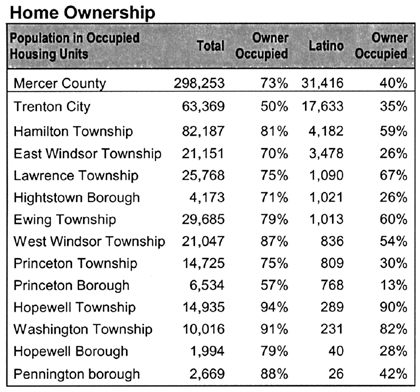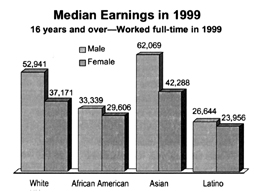
| NEWS |
| |
| FEATURES |
| ENTERTAINMENT |
| COLUMNS |
| CONTACT US |
| HOW TO SUBMIT |
| BACK ISSUES |

Latino Community Is Growing In Mercer County, Report Says
Candace Braun
Between 1980 and 2000, the Latino population in Mercer County more than tripled, to 33,898, up from 10,580, according to a report commissioned by the United Way of Greater Mercer County. In addition, local service-providing agencies estimate that in 2003, as many as 40 percent to 60 percent of the Latino population in the area are undocumented and uncounted, which could mean that the population is actually much higher.
Princeton Borough and Township are among the top five municipalities in Mercer County which have the largest concentration of the Latino community. Trenton has the highest population, with Latinos accounting for almost one-fourth of the city's population, followed by Hightstown and East Windsor.
This information was gathered by Lillian Escobar-Haskins, a researcher and writer specializing in community and human services issues. She was hired in 2002 by the Vision Council of the United Way to conduct the study of the Latino community.
Ms. Escobar spent more than 18 months conducting research to compile a report titled, "Latinos in Mercer County: A Reflection of the Changing Latino Population in the Northeast." The report was released on March 31 at a press conference held at the United Way facility in Lawrenceville.
According to the report, New Jersey is one of seven states that is home to 83 percent of undocumented individuals, according to the U.S. Immigration and Naturalization Service.
Latinos account for eight percent of Princeton Borough's, and six percent of Princeton Township's populations respectively. Caucasians account for 76 percent of the Borough, and 77 percent of the Township; African-Americans account for six percent of the Borough, and six percent of the Township; Asians account for nine percent of the Borough, and 11 percent of the Township; and another one percent of each municipality are of other nationalities.
In Mercer County, the Latino community accounts for 10 percent of the total population. Sixty-four percent of the population is Caucasian, 20 percent is African-American, five percent is Asian, and one percent is other nationalities.
The majority of Latinos living in Mercer County are Puerto Rican, while the majority living in Princeton are Mexican.
The median age of Latinos in Mercer County is 27 years old; under 18-year-olds make up 31 percent of the population, and seniors account for three percent.
caption:
|
Few Latino Homeowners
According to the report, in Mercer County, the Latino community has the largest family households, with seven percent of the population living with seven or more people in one residence.
In addition, only 40 percent of the Mercer County Latino community owns a housing unit, which is half as many as the Caucasian population, and nine percent less than the African-American community.
In Princeton Borough, 75 percent of of the total population owns a home, compared to only 30 percent of the Latino community. In Princeton Township, 57 percent of the community owns, compared to only 13 percent of the Latino community.
In light of such statistics, it is easy to see why overcrowding of residences in Princeton Borough has become a significant problem, spurring the passing of an ordinance in the fall that has allowed officials to issue a summons for an immediate court hearing to landlords in violation of housing codes.
Language Barrier
Often a problem in Princeton, as well as other Mercer County communities, is the language barrier that divides the Latino community from the rest of the population. Princeton has tried to combat this problem by offering various learning programs for children in both Spanish and English, as well as recently hiring a Latino liaison to communicate with Princeton's Spanish-speaking community.
However much of the Latino community still speaks Spanish as their first language, which becomes difficult for children who enroll in public school. Currently 71 students are enrolled in an English-as-a-second-language program in Princeton Regional Schools.
According to the Latino report, 59 percent of the Latino community in Mercer County speak English well or very well, while eight percent can't speak English at all.
When separating the language barrier into age groups, only two percent of children aged five to 17 years can't speak any English, which increases to nine percent in those 18 to 64 years, and increases again to 18 percent in those over 65 years.
Education, Profession
While examining the educational backgrounds of Latinos 25 years or older, it was found that only five percent of Mercer County Latinos have a graduate or professional degree, compared to 18 percent in Princeton Borough, and 26 percent in Princeton Township. Twenty-two percent of Mercer County Latinos have less than a ninth grade education, while 43 percent of Borough Latinos and 21 percent of Township Latinos have the same.
With the exception of African-Americans, all nationalities have more men than women in the work force, according to the report. Generally all nationalities fall within the 60 to 70 percentile of eligible individuals who are working. Seven percent of Latino men are unemployed, compared to eleven percent of women, which is fairly similar to the Asian population, but much lower than the African-American community, which has 14 percent of men unemployed, and 10 percent of women.
caption:
|
According to the U.S. Census, the median household income in Mercer County for Latinos in 1999 was $41,027, compared to Caucasian households, which averaged an income of $64,310. Latinos in Princeton Borough earned $65,313, compared to Caucasians, who made $80,019. In the Township, Latinos made $34,028, compared to Caucasians, who earned $106,555.
In 1999, a total of 18 percent of the Latino community in Mercer County were below the poverty level. This was comparable to African-American community, which was 19 percent below the poverty level. However only four percent of Caucasians fell into this range.
The United Way of Mercer County said the publication of this report represents an important step for the organization, which has set goals for itself to strengthen and support programs for Latinos; bridge Latinos in a culturally sensitive way into the systems that are available to meet their needs; empower them toward self-sufficiency; and build collaboration among Latino leaders and service providers to assess, evaluate, and recommend programs.
This report was printed with the help of Johnson & Johnson Family of Companies. To obtain a copy of the report, call (609) 896-1912.

